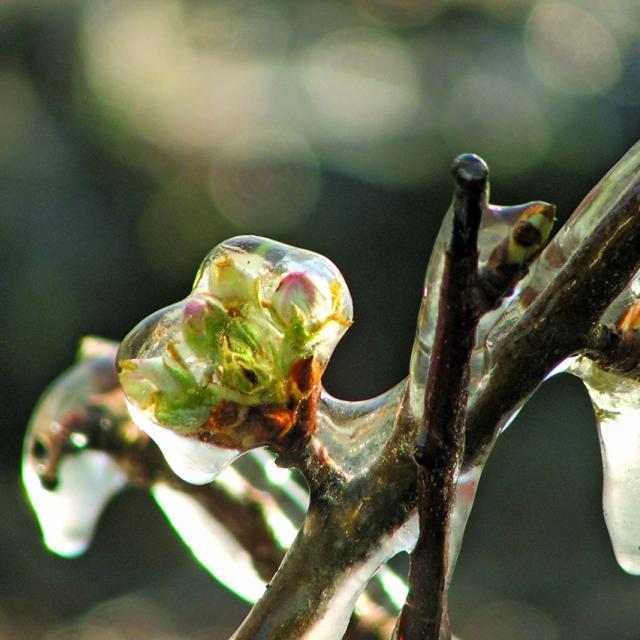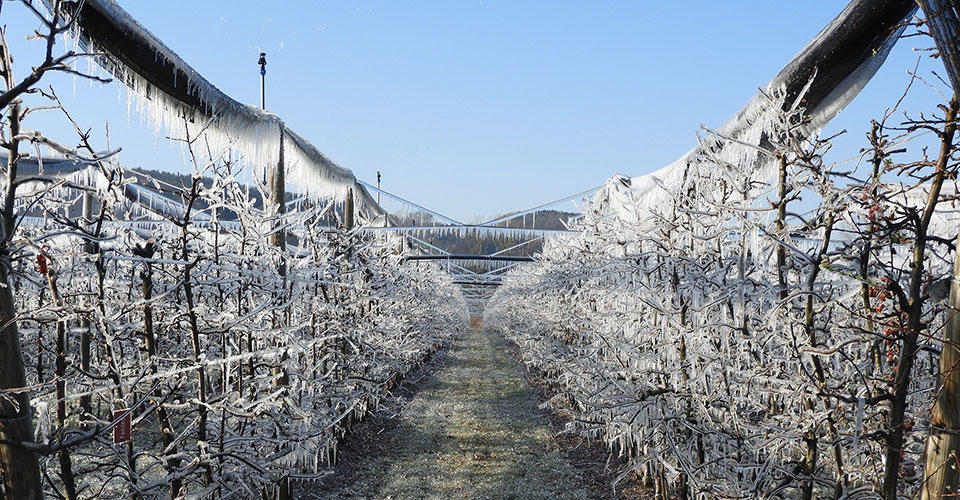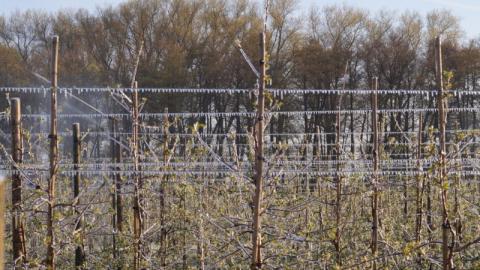Ice can form inside plant tissue due to ultra-low temperatures, harming plant cells
and frequently killing and ripening fruit. If not handled properly, low temperatures below 0° C (32° F) and freezing conditions seriously threaten crop growth and cause partial or complete losses.

Growers can protect their crops from frost damage using passive and active methods. Some passive techniques are site selection, plant nutritional management, and proper pruning, which can be implemented before a frost event to avoid the need for active protection. Active protection methods include heaters, wind machines, sprinklers, and more. The goal of active or direct frost protection systems is to modify field microclimates to prevent ice production in plant tissues right before the frost event or even during it.
The mix of passive and active methods can achieve better success in frost protection. The right choice is to consider various combinations of several potential passive and active scenarios during the initial planning stage before planting. With this in mind, growers can make active frost protection efforts more effective and minimize costs.
When compared to the vast majority of active systems, sprinkler irrigation can provide the highest level of protection. It is also among the most economical options for frost management — heaters (can be 5000 € per ha for 8 hours), wind machines (40/50 000 € for 5 ha), and sprinklers (8/10 000 € per ha). A sprinkler system's energy is significantly less than what growers would typically spend on heaters and other electrical equipment. Compared to these different solutions, it requires less labor and is relatively non-polluting. Overhead irrigation is used to protect low-growing crops and deciduous fruit trees with strong scaffold branches that do not break under the weight of ice loading.
How Frost Protection with Overhead Irrigation Works ?
Sprinklers can prevent frost by keeping plant temperatures at or near 0° C (32° F) based on the principle of latent heat.
As the air temperature falls below freezing levels, the sprinkler water starts to freeze and crystallize on leaves, branches, and buds. For every 1 gram (0.04 ounces) of water that freezes, the process of cooling the water results in the release of 80 calories of heat energy. The plant then receives the heat energy that the water losses. The plant is partially insulated from the extreme outside temperatures as the ice surrounds it.
Sprinklers provide a 2º to 5º C (35.6º to 41º F) temperature difference, which is just enough to protect plants. The method should protect the plant from severe damage as long as the water is constantly wetting it.
System Requirements
The over-plant sprinklers for frost protection should apply water constantly over the entire plant to help ensure that the area receives a sufficient application rate to prevent the plant tissue from losing heat energy and possible plant damage. The water application must be much more uniform than is necessary for irrigation so that no area receives less than the designated amount. Sources advise a minimum coefficient of uniformity (CU) of 80% for frost protection.
When the system is functioning correctly, water should gradually but steadily drop from the ice surrounding the plant. It should look like the ice is mostly clear. The application rate is adequate to prevent damage if a clear liquid-ice mixture is coating the plants and water is dripping from the ice. The application rate is too low for the weather circumstances if the water freezes and becomes milky white.
Application rate requirements for overhead sprinklers vary based on the sprinkler type, wind speed, minimum temperature, and crop type. As long as there is a liquid-ice mixture on the plants, with the water dripping off the icicles, the coated plant parts will be protected.
Consider These Factors
• Forecasting the minimum temperature and how it might change during the night is key to deciding if protection is needed and when to start the system
• Verify the system before an expected frost event
• Turn on the system when the wet-bulb temperature is higher than the critical damage temperature
• Ensure water is applied continuously
• Don’t shut down the system too early. Even if the sun is shining on the plants and the air temperature is above 0° C (32° F), sprinklers should not be turned off unless the wet-bulb temperature measured upwind from the crop is above the critical damage temperature
• Consider investing in a backup power source
• Consult with local extension service for recommended precipitation rate based on the crop

Wobbler Technology for Frost Protection
Wobbler sprinklers distribute water with exceptionally high uniformity over a wide area. Their instantaneous 360° distribution pattern, low operating pressure, and wind-resistant pattern make them one of the most effective sprinklers to combat frost damage. They gently apply an even layer of water over plants to keep them covered in ice. This uniform application avoids an abrupt drop in temperature.
The droplets produced by Wobbler sprinklers are relatively uniform in size, large enough to resist wind drift – thereby, they preserve the pattern’s integrity – but gentle sufficient to prevent damage to plants. Their thermoplastic construction and constant rotary action also prevent ice buildup and the sprinkler from freezing.
Low-pressure irrigation translates to reduced horsepower requirements and reduced energy use. With low operating pressures of 1,72 bar (25 psi) and under, Wobbler sprinklers are an economical option for frost protection and irrigation.
In contrast, many sprinklers used for frost protection, like stream-driven applicators, require operating pressures up to 3,45 bar (50 psi) for optimal results.
Compared to stream-driven devices, Wobbler sprinklers need less water and energy to achieve an equivalent result. Impact sprinklers wet a smaller area at a time and can take 60 to 120 seconds to make a complete circuit. Additionally, their metal components can cause them to freeze and stop.
Other Technologies for Frost Protection
NaanDanJain
Products for each application
Let’s talk about radiation frost, when the temperature near the surface of the earth drops below freezing point. Many methods have been used to protect fields and plantations. The use of sprinklers was found most efficient in most of the cases.
The methods and products for water application just for over-tree application are, overhead full cover where we try to fully cover the plot, targeted watering means a solution to cover only the tree canopy, and strip watering is oriented on crops guided on trellised farming.
NaanDanJain products for each one of these applications are:
• Overhead full coverage. Metal sprinkler 233 is a reference in the frost protection market. Super 10 and Mamkad are very interesting options when we want to have a low angle profile to protect under nets.
• Targeted watering: actually, the Aquasmart 2002 is the best solution for such frost protection purpose and its large range of discharge and swivel allow to taylor made the installation. The AquaMaster 2005 is also a good option used in many countries.
• Strip watering: Flipper is the perfect solution for having strong protection (6-8mm/hour on the strip) and reduced water consumption (25m3/ha). It is an experienced product used a lot on apples and vineyards with great success.
NaanDanJain's sprinklers are designed to offer a number of definitive features to be chosen in frost protection applications, such as rotational speed, range, uniformity of water sheet distribution, and droplet size, and so on.
Nelson Irrigation
The R10T Rotator® with P8 24 degree Brown plate
An economical overhead frost protection sprinkler from Nelson Irrigation is the R10T Rotator® with P8 24 degree Brown plate. It is commonly used on 9 x 9 meter or 9 x 12 meter spacing. Application rates in the range of 4 mm/hr for overhead frost control are achieved using the #12 purple and #13 yellow nozzle. Overahead frost control is successful when enough water volume (or high enough application rate) is used to keep the ice crystals formed clear or transparent in appearance during the frost event clear. Rotation speeds of the R10T are about 20 to 30 seconds which is important as each ice crystal has new water applied to it frequently.
Perrot
A sprinkler that neither freezes nor rusts
For maximum reliability in the most sensitive growth phase, use Perrot’s ZS sprinklers
Nowhere is a reliable sprinkler system more in demand than in frost protection. Thanks in particular to our impact technology, PERROT ZS sprinklers can function perfectly at temperatures even as low as -10 degrees without freezing. This ensures an even and low-consumption allocation of water even over long periods of hours.
Technical specifications of ZS30: • Nozzle sizes: 3.5 - 5.2mm • Operating pressure: 2.5 - 4.5 bars • throw distance: 13.0 - 16.3m
• water consumption: 0.69 - 2.04 m³/h • Beam Rise: 30°
• Connection: 3⁄4” AG
Netafim
MegaNet
The MEGANET sprinkler provides very uniform water distribution and allows the farmer to mitigate the effects of frost damage by reducing water consumption.
This is a pop-up sprinkler that prevents clogging by insect invasion inside the nozzle or the sprinkler mechanism.
The operating pressure can range from 2 to 3 bar.
The MEGANET sprinkler can be supplied with the option of a pressure regulator, making it more suitable for variable topographies and longer rows.
This sprinkler is available with water trajectory angles of 15° or 24° and 7 different flow rates, creating the possibility of having fourteen different combinations to cater for all the orchard’s configurations.
Two identical water jets allow for a perfect balance and more frequent amounts of water applied to the crop to ensure optimum frost protection in the spring.
The MEGANET is used for frost protection in a solid set system. If you want to reduce your consumption by applying the water directly to the crop and not the uncultivated areas, then think about using our SUPERNET and PULSAR sprinklers.
Rain Bird
The Rain Bird LF sprinkler
The Rain Bird LF sprinkler offers the following specific features for efficient frost protection:
• An exceptionally good uniformity of distribution (optimum droplet sizes),
• Rapid rotation time (Constant rotation time <30 seconds despite variations in temperature and pressure)
• Functions reliably at low temperatures
The drive unit is protected from an accumulation of ice (often causing the rotation speed to slow down) by a robust plastic cover.
The LF sprinkler has been successfully evaluated at temperatures as low as -13° C, without any reduction in the rotation time.
The LF sprinkler was successfully assessed during the recent spells of freezing temperatures in France and it has been promoted and used for the frost protection of crops in Europe, United States, Chile, Australia and China.
Technical specifications: • Operating pressure 1.7 to 4.2 bar • Flow range 220 to 913 l/h • Throw radius range 6.6 to 15.2 m • Deflector trajectory outlets 6°, 10°, 12°, 13°, 15°, 16°, 17°, 21°, 22°
Rivulis
The Rivulis Super XL sprinkler
The Rivulis Super XL sprinkler provides for a wide range of frost protection applications. Due to its design, the sprinkler has flexibility for various installations. It can be used in under-tree protection applications, in applications of overhead tree protection with one sprinkler to each tree, and even in applications that protect multiple trees from the same sprinkler.
Inside the Rivulis Super XL is a rotor where the speed is controlled by a viscous silicone fluid within the bearing of the rotor. This silicone drive mechanism enables the sprinkler to provide a slow rotation that delivers a single jet of water. Being just one strong jet of water, the sprinkler allows a wide wetting diameter, even in conditions with wind.
4 different flow rate options between 191 and 341 l/h (at 2.5 bar) are available. Both 3⁄8” and ½” base models are also available.

